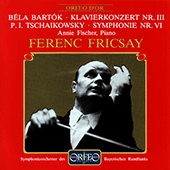Annie Fischer
At the Liszt Academy of Music, Fischer studied with Arnold Székely and Ernő Dohnányi. During this period of study she was twice awarded the Liszt Prize. At the age of ten she made her debut playing Beethoven’s Piano Concerto No. 1 Op. 15 and in 1928 played for the first time outside of Hungary in a concert in Zürich with the Tonhalle Orchestra. At this concert she played two concertos: Mozart’s A major K. 488 and the Schumann Piano Concerto Op. 54. It was in 1933 that her career was boosted by her taking the first prize in the first International Franz Liszt Piano Competition (where Louis Kentner was placed third). Apparently, it was Fischer’s performance of Liszt’s Piano Sonata in B minor that was so impressive: one of the judges on the panel was Liszt pupil Emil von Sauer.
This was the beginning of a European career interrupted by World War II, which Fischer and her husband spent in Sweden. Returning to Budapest in 1946, a city in which she spent most of her life, Fischer resumed her career. Three times she received Hungary’s highest cultural award, the Kossuth Prize, and was also awarded an honorary professorship at the Liszt Academy in 1965. Fischer did not like to travel much outside of Europe, make records, or be interviewed; however she did play in Australia and New Zealand, Japan and the USSR, and first visited America as late as 1961, playing a Mozart concerto at Carnegie Hall with George Szell and the Cleveland Orchestra.
As a pianist Fischer has been likened to Cortot where the communication of the spirit of the music was the most important fact of playing in public, but in studio recordings she did not seem to have that added dimension of fantasy that Cortot gave to his performances. Like Cortot though, Fischer often played wrong notes in her performances, and, again as with Cortot, these did not detract from the strength of her interpretations, and certainly did not matter. Fischer’s repertoire was predominantly Mozart, Beethoven and Schubert, but she played music by other composers including her compatriots Liszt and Bartók. She recorded a fair amount of her repertoire for HMV in the 1950s and 1960s and all of the Beethoven sonatas for Hungaroton in the 1970s, but she was not satisfied with the Beethoven sonatas and did not allow their release. They were published only after her death.
The HMV recordings include a 1960 performance of Liszt’s Piano Concerto No. 1 in E flat, but this is a disappointment with slow tempi, possibly instigated by the conductor Otto Klemperer. Far better are some fine Mozart piano concertos recorded with the Philharmonia Orchestra. Fischer recorded major solo works by Schumann, Beethoven and Schubert for HMV including the Fantasie Op. 17, Carnaval Op. 9, Kinderszenen Op. 15 and Kreisleriana Op. 16, some of the more well-known sonatas of Beethoven and Schubert’s Piano Sonata in B flat D. 960. However, the recorded sound in these recordings hardly does her justice, with her tone at times sounding opaque and brittle. The best of these recordings are Beethoven’s Sonata Op. 109, Schubert’s Sonata in B flat D. 960, and a dramatically-etched Kreisleriana Op. 16 of Schumann, one of her best HMV recordings.
Of her recording of Beethoven’s Piano Concerto No. 3 Op. 37 made for Deutsche Grammophon in 1957 Richard Osborne wrote, ‘For drama, power, imaginative reach and the astonishing sense it conveys of improvised intellectual gamesmanship, the performance is probably without peer in the annals of this concerto on record.’ It is a fine performance, as was another recording of the same work she made for Hungaroton in 1966 with the Budapest Symphony Orchestra and Heribert Esser.
Fischer did not like recording and some of her best playing can be heard in such live performances as that of Bartók’s Piano Concerto No. 3 with Ferenc Fricsay and the Bavarian Radio Symphony Orchestra from 1960 in which Fischer’s tone is perfectly and naturally caught. A recital she gave at the Edinburgh Festival in 1961 was recorded by the BBC and recently issued on compact disc. Here Fischer’s grasp of Brahms’s Piano Sonata in F minor Op. 5, a difficult and unwieldy work, is compelling and impressive. She also plays music by three of her compatriots, Bartók, Liszt and Dohnányi, where exemplary performances of Liszt’s sixth Grande Étude de Paganini and Dohnányi’s Rhapsody No. 3 really show what Fischer was capable of. Two further releases by the same label include excellent accounts of Schumann’s Kinderszenen Op. 15 and Fantasie Op. 17.
© Naxos Rights International Ltd. — Jonathan Summers (A–Z of Pianists, Naxos 8.558107–10).


















